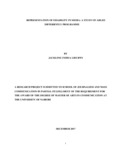| dc.description.abstract | The study examined representations of disability in media focussing on the Kenya national broadcaster, Kenya Broadcasting Corporation Television (KBC TV). The study investigated how KBC TV’s premier program Abled Differently is representing People with Disabilities (PWD). The study mixed qualitative and quantitative methods with the population being Abled Differently program, and stakeholders in the disability movement. Non-probability purposive sampling was used to select 26 episodes of Abled Differently, and a purposive sample of 10 key informants drawn from the program’s technical team and stakeholders in the disability movement in Kenya. Quantitative data was collected using a content analysis tool and analysed using descriptive statistics. Qualitative data was obtained using interview guides and analysed thematically. Findings indicate that Abled Differently show employs code-switching, sign language and subtitles that aid comprehension of content, and enhances program reach. The show centers on characters who appear rather than their disabilities. The show also features PLWDs as professionals. However, the producers need to develop a more critical angle when framing stories on PLWDs, so that myths on PLWDs are dismantled. Conclusions drawn from the study indicate that Abled Differently show was KBC-TV’s own production, following an original concept, which affords the media house flexibility in content selection. The show presents a paradigm shift from the stereotypical portrayal of PLWDs in mainstream media, which and potentially contribute to a more tolerant and inclusive society. Recommendations are that producers need to engage more stakeholders in the production of the show in order to give a more diverse and robust view of PLWDs issues, as well as critical and varied content. Further, more PLWDs can be portrayed undertaking everyday roles so as to promote their acceptance and inclusion in society. | en_US |



